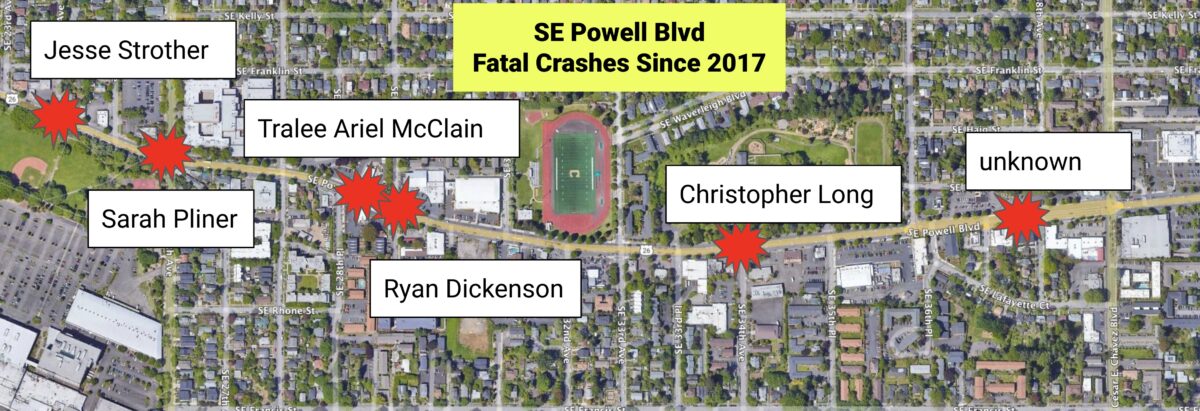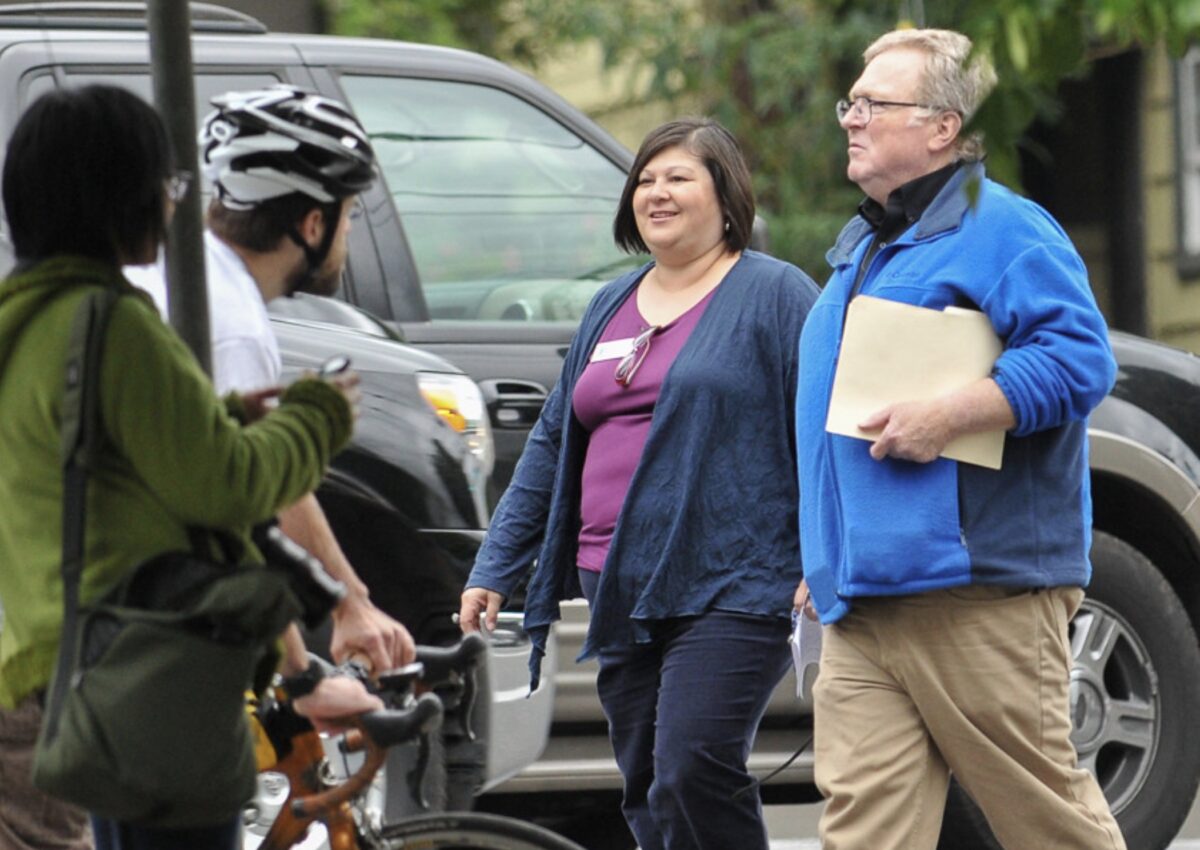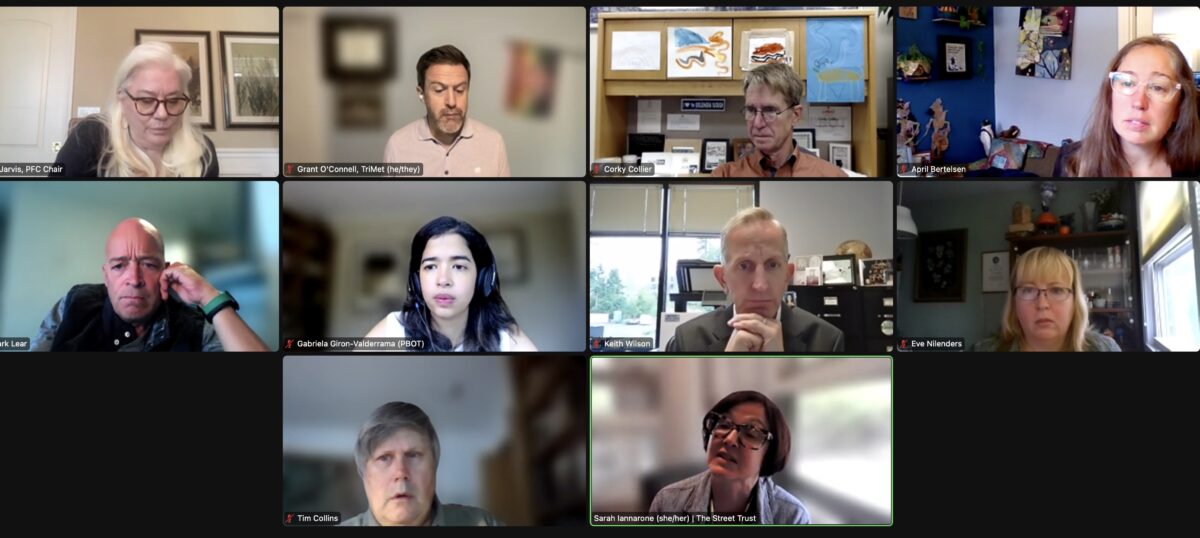
Another senseless death of a vulnerable road user on an urban highway controlled by the State of Oregon has led to more pleas from advocates to make changes. And just now, the Portland city commissioner in charge of the transportation, Jo Ann Hardesty, added her voice to the chorus.
“Enough is enough,” Hardesty said in a statement Thursday. “In the immediate term… ODOT can make changes to Powell and other urban arterials today… ODOT must implement safety improvements as soon as possible for the safety of Portlanders and all who travel through our city.”
Hardesty said she wants to see changes like the ones suggested by The Street Trust in their statement yesterday. Specifically, they have called for a protected intersection design that would create physical separation for vulnerable road users.
Yesterday as I biked home from the intersection where Sarah was killed, I got a phone call from ODOT Region 1 Public Information Officer Don Hamilton. Hamilton knows SE Powell and 26th well. In 2015 he went so far as to attend a protest at the intersection held two days after a bicycle rider has his leg torn off in a collision with a truck driver at the same location.
Hamilton said he was aware of demands for accountability from The Street Trust and Bike Loud PDX. “People are saying ODOT has to answer for what happened,” he said. “But we still don’t know what happened so it’s premature to blame us.”
“We need to know if Powell played a role, and if so, what role, before we can decide if there’s anything further we can do,” he added. “I don’t know if conditions on the road can be seen as a factor.”
According to our Fatality Tracker there have been 10 fatal traffic crashes on SE Powell between 24th and 62nd since 2017 — six of them are on the stretch between 24th and 37th.

Regardless of what happened Tuesday, does ODOT not believe that the current design on Powell Blvd is inherently dangerous?
Hamilton carefully evaded that question and would only say: “If there’s something we can do we, we will do it. It is a busy road, there are a lot of dangers, and everyone needs to be very careful.”
We still don’t know exactly what happened between Sarah and the driver of that truck. Because one party in the collision cannot speak for themselves, because there are many conflicting witness accounts that don’t add up, and because even video evidence doesn’t always show everything, there’s a chance we might never know.
What is clear so far is that the design of Powell Blvd at 26th Avenue and the safety of people who use it are completely at odds. It’s a ticking time bomb. And ODOT holds the fuse, a match, and a cup of water that could put it out. So why do they just stand there and let it burn?
As I talked to ODOT’s Hamilton, he kept saying “It’s a very busy road… it’s so dangerous,” as if the road is a force of nature his agency has no control over. The same way someone might look at a school of sharks and say, “It’s a lot of sharks… it’s so dangerous.”
The difference in those two examples is that one we have control over, and the other we don’t. We — or in this case specifically, ODOT — has control over this situation. They decide how a road is designed. And design influences how a road is used.
In this case, so far it appears that neither person involved in this tragedy did anything egregiously wrong.
At the Portland Bureau of Transportation Freight Advisory Committee meeting this morning, The Street Trust Executive Director Sarah Iannarone said, “I want us to do everything that is possible to prevent these in the future. That is why I want to place blame on the infrastructure…. Because whether or not there is human error involved on anyone’s part, we need to do things as a community to prevent harm when human error is a factor. Humans err, that is what we do.”


ODOT erred when they made an intentional decision in 2018 to make SE 26th and Powell less safe for cycling, so did The Street Trust when they went along with the compromise (which Iannarone apologized for at today’s meeting). There used to be a large, green-colored bike box on the corner where Sarah Pliner was killed. ODOT chose to remove that bike box and strip the bike lane of its legal status in 2019 (even after their own consultants told them widening the bike lane would be a feasible option). The purpose of a bike box is twofold: Provide space between drivers and bike riders during red lights, and to give a visual warning of potential bike rider/driver conflicts. A bike box probably wouldn’t have kept Sarah alive; but it doesn’t change the fact that ODOT made this corner less safe and now someone is dead.
I asked ODOT PIO Don Hamilton why ODOT removed the bike box. “We were trying to direct bicycle to a safer crossing on 28th. We certainly were not intending to make bicycle traffic less safe,” he replied.
So why not just put up signs pointing to 28th and keep the bike box? I asked.
“I see what you’re getting at,” Hamilton replied, ever cautious with how he chooses words during our conversations. “We made a decision to make sure that the facilities that we had at 26th directed traffic as best we could to 28th Avenue… You understand what we were doing right? I see your point though, when you remove something, are you are making it less safe? I get that. I see what you mean.”
ODOT often has no trouble seeing what we mean. They just usually don’t agree with our solutions.
At the intersection where Sarah died, the solution must address how truck drivers turn (or if they’re allowed to continue doing so).
Today, the way truck drivers make the turn from northbound 26th to eastbound Powell is extremely dangerous. A ticking time bomb. Several very knowledgeable people I’ve spoken about this recently have said the same thing: “I can’t believe this doesn’t happen more often.”






